Catalogue > List by artist
Browse the entire list of Rencontre Internationales artists since 2004. Use the alphabetical filter to refine your search. update in progress
Bea De Visser
Catalogue : 2012Chairs Missing | Experimental film | | color | 19:45 | Netherlands | 2010
Bea De Visser
Chairs Missing
Experimental film | | color | 19:45 | Netherlands | 2010
The last days of a swimming pool, just before the demolition. Regular visitors are isolated by mysterious encounters, nowhere to be seen in the film. We see the decline of a social meeting place unfold in sequential patterns. Without dramatic event, no music, no dialogue, this film is in relation with the `minimal` art cinema. ... A man walks through the hallways past lockers and cubicles. A boy plays in one of the lockers. A girl walks into a dressing room, opens the door, but does not enter. A boy walks past the grandstand where a young woman stares into the water. A woman swims her baby to the edge of the pool. The building is filled with sounds: water, machinery, leaking outside noise like the sound of emptiness. And old man steps off the high dive ... We come to know anything about the people we `follow` or meet. Everyone seems calm and happened to come by. It derives the film its quality as stylized documentary observation or film essay. Yet there is turmoil and tangible threat.
Bea de Visser works as a autonomous visual artist and filmmaker. She started her career in the early 1980-s; she works as a sound and performance artist in the trendy club scene and artists spaces. Today, her work is shown at international exhibitions, her movies shown at international film festivals worldwide. Bea de Visser manages to present the independent production studio Anotherfilm. In the recent past Anotherfilm has become an initiative that participates in hard to realize projects of a small group of artists and filmmakers. Since 2010 Bea de Visser works as guest advisor at Rijksakademie van Beeldende Kunst in Amsterdam. She is art consultant of the Collection Lievensberg in Bergen op Zoom. Occasionally she gives workshops and lectures at home and abroad in various disciplines such as film, scenario, drama, visual arts and theater design. Her films include: Mama Superfreak (2009), Roses and Fall (2006), Just a Minute Yoko (2004), The Second Memory (2004), The Barren Land (2001), Another Another (1999), A Breath Hush (1996). Besides she made music videos, films for theatre design and wrote scenarios for feature film projects.
Catalogue : 2010MAMA SUPERFREAK | Experimental fiction | | color | 14:0 | Netherlands | 2009
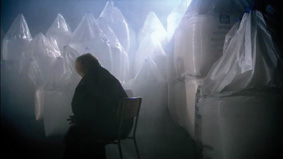
Bea De Visser
MAMA SUPERFREAK
Experimental fiction | | color | 14:0 | Netherlands | 2009
In one long shot this adaptation of La Mamma Fricchettona, a monologue by Nobel Prize winner Dario Fo, shows Viviane De Muynck in a humorous elucidation of a woman? s odyssey from doting motherhood to a state of independence whilst addressing an invisible and anonymous man. In an ambiance of a warehouse filled with white sacks the protagonist vociferously relates her non-existent relationship to husband and child and her escape to the alternative underground of squatters and punks, who are more of a family to her than her own brood.
She starts her career as a performance artist; beginning the 1980ies she performs on the podia of the trendy club circuit and the alternative art spaces with sound work, live installations and `noise` performances. Afterwards she returns to painting and works for two years at the Rijksakademie van Beeldende Kunst in Amsterdam (1993-1995). As from that time film is her medium. The work that she develops since then is shown worldwide in museums and art spaces, the theatre, the public space and especially the cinema. Her short films are: SSST?, Roses and Fall, Just a Minute Yoko, The Second Memory, The Barren Land, Another Another and A Breath Hush. `Cold` is her first feature film (in production 2009).
Guzman De Yarza
Catalogue : 2009COMBATE | Art vidéo | dv | color | 6:30 | Spain | 2007

Guzman De Yarza
COMBATE
Art vidéo | dv | color | 6:30 | Spain | 2007
The projects tries to construct a visual metaphor in order to rethink the concept of conflict that lies beneath every human form of relation, and also to study violence as an organized mass media spectacle in contemporary society. We have recently observed the rapid growing of contact sports and all kind of brutal martial arts, from which one stands out above all, the so called Extreme Fighting, in which two contestants fight with almost no limits in the ring, using a mixture of all martial art disciplines. The work tries to investigate in the relation between the mechanisms of knowledge transmission both in the martial arts world and in University, relating the competitivity that is taught daily to the art of killing what is different form you?
Guzmán de Yarza Blache. Zaragoza, Spain. 1976 Architect by Universidad de Navarra. Spain After working at Andres Perea Office of Architecture in Madrid, founds J1 Architects in 2002, a Madrid based office of architecture that currently projects and directs works in several parts of Spain. He develops simultaneously a career as a video artist in a disciplinary mixture that in his own words enriches both practises and allows an exchange of sensitivity that eventually aims to somehow illuminate our perception of human condition. His interests as an artist are basically related to the act of portraying and to the description of contemporary society, for what he performs public art pieces and documental like productions that pose questions on a range of things that vary from the very intimate scale to that one national or transnational, with constant references to architecture and urbanism and the way they both dramatically affect our lives.
Catalogue : 2008No les Hables de Lenin | Art vidéo | dv | color | 6:3 | Spain | 2006
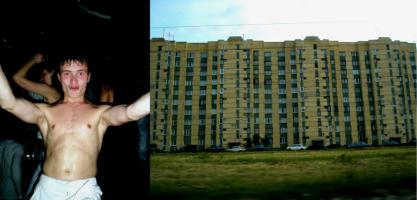
Guzman De Yarza
No les Hables de Lenin
Art vidéo | dv | color | 6:3 | Spain | 2006
Selection of portraits taken late at night in different clubs and after hours in major Russian siberian cities in the summer of 2006. A collective portrait of the first generation of Russians born free that have learned amazingly fast those western rituals of leisure and hedonism through global television networks and that, supported by extremely flexible opening times, are currently developing a sensuality and a joie de vivre that somehow tries to compensate all that stolen time to previous generations. The project is indeed a documentary approach to three big industrial Russian cities, located within the Trans Siberian Route, Yekaterimburg, Novosibirsk and Irtkusk, where more than four hundred portraits where taken during a five week trip, from which around sixty have been chosen with the intention of achieving some knowledge about a generation of Russians whose life conditions have changed dramatically compared to those from their parents. The portraits are presented in a diptic with pictures of buildings belonging the cities where these main characters live, creating a catalogue of both soviet architecture and of the new mall-like constructions and ? western ? looking architectures. The project not only intends to investigate on how much of architectonical can lie in a face or how much of anthropomorphic can there be in a building, but also points out one of the main aspects of contemporary society which is the assumption of global trends by younger generations, always related to leisure time and hedonism, that are beginning to define a social battle field in which the new revolutionary attitude is to see how hard you can party and how little you can sleep?
Architect by Universidad de Navarra. Spain After working at Andres Perea Office of Architecture in Madrid, founds J1 Architects in 2002, a Madrid based office of architecture that currently projects and directs works in several parts of Spain. He develops simultaneously a career as a video artist in a disciplinary mixture that in his own words enriches both practises and allows an exchange of sensitivity that eventually aims to somehow illuminate our perception of human condition. His interests as an artist are basically related to the act of portraying and to the description of contemporary society, for what he performs public art pieces and documental like productions that pose questions on a range of things that vary from the very intimate scale to that one national or transnational, with constant references to architecture and urbanism and the way they both dramatically affect our lives.
Arthur Debert
Catalogue : 2026La Conférence des Instruments Savants | Experimental video | 4k | color | 9:1 | France | 2024
Arthur Debert
La Conférence des Instruments Savants
Experimental video | 4k | color | 9:1 | France | 2024
In a wooden amphitheatre built in 1933 for the study of animals and plants, a group of ancient tools attend a lecture. The talk seems to be about animals and their movements, but the tools gradually come to understand that it’s about the living beings that have given them their names and sometimes even their shapes.
Born in Paris in 1990, Arthur Debert lives and works between Nancy and Berlin. Arthur Debert’s protean practice is rooted in collective work and exchange. Anchored in a contextual approach, his work takes shape through travel, encounters and multiple collaborations. Central to these exchanges is the question of the transmission and survival of knowledge. Objects encountered in the field are seen as both witnesses and bearers of epistemological narratives to be deciphered. To reveal the different cultural layers sedimented within them, the artist disrupts their temporal linearity through shifting spatial settings and collective activations. Installations, videos and editions then fix the ephemeral, indeterminate state of the resulting lived experiences. Arthur Debert is a graduate of the École de l’Image in Épinal (2011), the École Supérieure d’Art de Lorraine in Metz (2013) and participated in the École Offshore in Shanghai (2014-2015), a research program of the École Nationale Supérieure d’Art et de Design in Nancy. His work has been shown at Centre Dürrenmatt Neuchâtel (2025), Triennale de la Jeune Création (Luxembourg, 2013 and 2021), Koraï (Cyprus, 2023), Ann Arbor Film Festival (Michigan, 2022), Berlin Art Prize (2018) and Berlin Independent Film Festival (2023).
Edouard Decam
Catalogue : 2023Calibration | Experimental film | 16mm | color | 15:49 | France, Spain | 2023
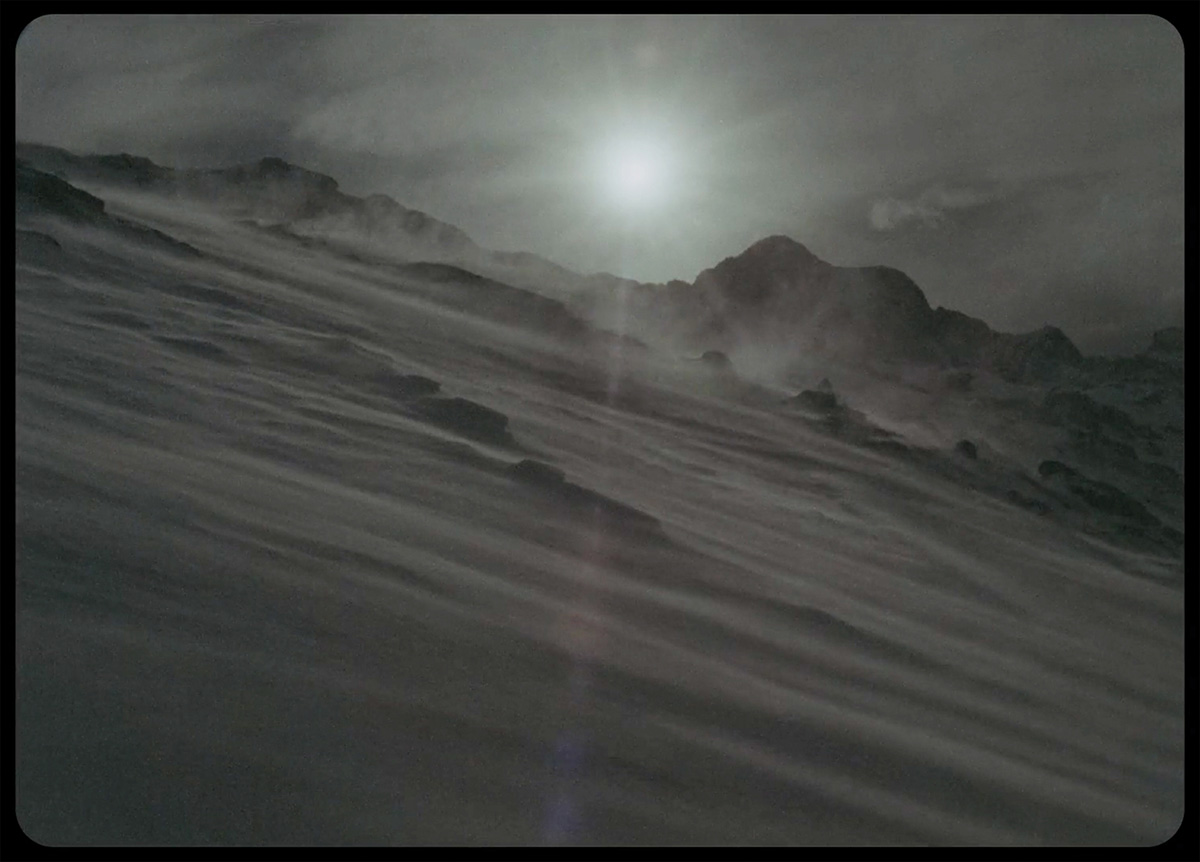
Edouard Decam
Calibration
Experimental film | 16mm | color | 15:49 | France, Spain | 2023
« Tout a tendance à dériver avec le temps et perd de sa précision de façon périodique. Un ajustement assure que la précision reste au niveau requis. » Comme une invocation, une nécessité de calibration du paysage qui perdrait petit à petit sa condition naturelle, le film projette une nature mouvante, en constante modification et réajustement. Les niveaux de vents, hauteurs de neiges, les compositions physiques, géologiques, morphologiques et temporelles s’étalonnent lentement, la montagne s’équilibre. Dans la continuité de « Volva », film tourné en 2016 à l’observatoire astronomique du Pic du Midi, « Calibration » est une expérience physique de la nature, d’un temps vécu, en plein hiver, isolé dans un refuge de haute montagne durant trois semaines, au contact des aléas du vent, de la neige, des lumières et du temps.
Architecte de formation il collabore dans diverses agences avant de se consacrer exclusivement à sa pratique artistique. En 2006 il est lauréat de la bourse de la Fondation EDF pour les jeunes architectes. Il réalise le projet photographique Landscape scale sur les barrages des Pyrénées qui marquera la direction de ses futurs projets. Il centre ses recherches sur les relations qui se tissent entre l’architecture et le paysage, entre l’homme et la nature. Ses recherches tentent de construire la part impalpable de notre relation au naturel. Ses installations se développent entre photographies, vidéos et volumes construits. En 2016 il réalise son premier film, Volva à l’observatoire astronomique du Pic du Midi. Durant 3 semaines passées à 2871m, il capte inlassablement les traces du temps imprimés dans les expériences scientifiques, l’architecture du lieu et le paysage environnant. Nominé dans divers festivals, Volva est lauréat du prix LOOP Discover à Barcelone. Il intègre la collection du MACBA et du FRAC Normandie Caen. Il a été résident de la Casa de Velázquez et de l’Institut français. Ses travaux sont exposés en Europe, aux Etats-Unis et intègrent diverses collections publiques, FRAC, musées et Fondations. Il vit et travaille à Argut-Dessus, dans les Pyrénées.
Alain Declercq, Jeanne SUSPLUGAS
Catalogue : 2013Pill-boxes | Video | dv | color | 10:0 | France, Switzerland | 2012
Alain Declercq, Jeanne Susplugas
Pill-boxes
Video | dv | color | 10:0 | France, Switzerland | 2012
En Suisse, plus de trois-mille bunkers ont été construits entre 1882 et 1995. En 1914, l?aviation entre pour la première fois dans l?histoire d?un conflit armé et engendre des changements de stratégies : il devient nécessaire de se cacher, c?est la naissance du camouflage. Les ouvrages militaires suisses ont été camouflés par d?étonnantes décorations, si bien intégrés au paysage que personne ne les remarque: du sapin métallique de Fort Pré-Giroud (Vallorbe) au porte rocher de Gütsch (Uri). Cette singulière architecture témoigne de la neutralité Suisse et questionne la relation entre architecture et paysage. Aujourd?hui, la plupart de ces fortins sont désaffectés et posent la question du devenir de cet important patrimoine.
De la vidéo à la photographie, de l?installation au dessin, Jeanne Susplugas évolue dans un univers aussi séduisant qu?inquiétant avec comme préoccupations principales nos addictions. Elle crée des espaces pénétrables, des « maisons » qui questionnent le spectateur sur des comportement sociaux et intimes. Susplugas est représentée par la galerie Valérie Bach (Bruxelles), Mizuma Art Gallery (Tokyo) et Rewind (New York). Alain Declercq explore les différentes structures du pouvoir et les oppressions qu`elles engendrent - schizophrénie sécuritaire, surveillance, manipulations médiatiques. Sa technique de l`inversion transforme Declercq en chasseur d`indices, provocateur de dysfonctionnements, renverseur de situations ou empêcheur de tourner en rond. Declercq est représenté par les galeries Elaine Lévy (Bruxelles) et Loevenbruck (Paris).
Catalogue : 2012Protection civile | Experimental video | 0 | color | 15:44 | France, Switzerland | 2011
Alain Declercq, Jeanne SUSPLUGAS
Protection civile
Experimental video | 0 | color | 15:44 | France, Switzerland | 2011
PROTECTION CIVILE seems the obvious continuation of the first film made by Alain Declercq and Jeanne Susplugas PLAN IODE (which questions the distribution of potassium iodide, vital drug in case of a nuclear attack). After the pharmacies backrooms, it is the under ground Swiss shelters the two artists went to explore. The country abounds of those shelters and each inhabitant has a space. Individual or collective, from particular cellar to enormous medicalized shelters, they all answer a strict and effective organization. The film then questions a possible presence under ground, the limits of the cohabitation, promiscuity and the inevitable problems of organization what raises such a plan of protection. In panoptical and systematic form, appear dormitories, kitchens, surgical unit, medical and emergency material. However in some of these spaces, transformations are taking place, changes of affectation or use. So, certain shelters can serve as heterogeneous storage places which can sometimes take an improper aspect... The artists testify through this movie of the singular and unique architectural heritage of Switzerland.
Alain Declercq is a french artist, born in Moulin in 1969. He works and lives in Paris, his work has been exhibited since 1996. He's represented by the Hervé Loevenbruck art gallery in Paris, and by the Elaie Levy Project Gallery in Belgium (Brussels).Jeane Susplugas is a french artist, born in Montpellier in 1974. She works and lives in Paris. She's represented in Paris by the JamoisArtPartners Gallery, in Brussels by the Charles de Jonghe Gallery, in Copenhagen by the Poulsen Gallery and in Tokyo by the Mizuma Art Gallery.
Jason Dee
Catalogue : 2009We're going for a trip across the water | Experimental video | dv | black and white | 2:0 | United Kingdom | 2006
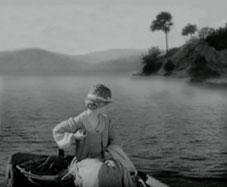
Jason Dee
We're going for a trip across the water
Experimental video | dv | black and white | 2:0 | United Kingdom | 2006
A couple in a rowboat are caught in a never ending circle. They appear to be trapped within the mechanisms of the film itself. The looped rowing action of the man gives him the appearance of an automaton, while the flickering image of the woman frozen at the boat's rudder has a ghostly quality. The actors, or rather their images, are caught in a state of limbo between past and present, movement and stasis, life and death. Differing forms of recorded time are brought together in this work, forcing different perceptual rules to combine. The merger of still images and film motion acts to deform cinematic narrative. The ceaseless forward motion of the storyline has been caught in a loop, creating a film requiring a contemplative approach from viewers more akin to photography or painting. The past and present merge together preventing the possibility of a narrative ending, creating a work complete within itself, yet forever unresolved. Technologies from several different eras are referenced. The lakeside backdrop spinning around the couple is actually a still image created by digitally stitching together individual film frames into a 360-degree panorama, while the man's looped animation resembles a 19th century Zoetrope sequence.
Jason Dee studied photography at Northumbria University and completed a Masters in Fine Art at Glasgow School of Art. His current art practice investigates connections between modern media from the mid 19th century to the present day. He uses digital software to alter film scenes originally shot on celluloid, assessing how new media has reconfigured and re-contextualised the way we perceive 20th century cinema. His work has been exhibited in Europe and the United States. Dee is currently undertaking a year long new-media residency at the University of Abertay funded by the Scottish Arts Council. He lives in Dundee, Scotland.
Catalogue : 2008Moonscape | Experimental video | dv | color | 2:30 | United Kingdom | 2007
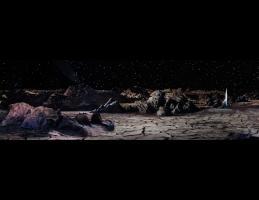
Jason Dee
Moonscape
Experimental video | dv | color | 2:30 | United Kingdom | 2007
Moonscape is a continuously looping panorama, made by digitally stitching together painted backdrops from numerous 1950?s sci-fi films. These films looked forward to the future ? yet created their futuristic effects by returning to cinemas roots. They were shot in Cinemascope, at the time, cutting-edge technology , yet it?s format and the use of painted landscapes harked back to 19th Century panoramas. ?Moonscape?, merging paint, celluloid and pixels, continues this sense of simultaneously looking back and forward. In the 1950?s, these landscapes had to be imagined; yet they also contained scientific details from a society on the verge of space travel. Hand-painted backdrops, blended with lens-based imagery, fantasy merged with scientific facts, as the imagined paintings become infused with film?s reality effect. Viewing these landscapes now, after manned lunar exploration appears to have come and gone, the pioneering optimism (expressed in the use of Technicolor and Panovision) has given way to a more desolate and directionless viewpoint. This panorama shows a distant suspended world, sealed off and preserved from the world and time. Distant ghostlike spacemen look isolated and without purpose, caught in limbo on an imagined future landscape of celluloid and paint that became reality and is now slipping back into memory.
Jason Dee is a graduate from Glasgow School of Art`s MFA programme. He continues to live in the city, working on his art practice while occasionally teaching New Media skills and lecturing at the Art School. His work has been exhibited and screened at venues throughout Europe and the USA.
Olivier Degorce, Christophe GRISEAU
Catalogue : 2006Wall Street (épisode 1) | Experimental video | dv | color | 4:3 | France | 2004
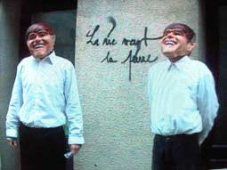
Olivier Degorce, Christophe GRISEAU
Wall Street (épisode 1)
Experimental video | dv | color | 4:3 | France | 2004
Après l?échec d?un avenir radieux annoncé par le communisme, nos amis les clones, chantres du capitalisme, décident la mise en faillite délibérée d?entreprises. EXTRAIT D?UN ENSEMBLE DE FILMS REGROUPÉS SOUS LE TITRE : « In The World Of Opulence » Les films se jouent des sujets épineux et calamiteux de nos sociétés contemporaines. Les thèmes récurrents qui ont influencé OBSESSION 27 (l?isolement social, l?exclusion, la jet set, la perversité, certains fléaux planétaires?) sont illustrés avec légèreté ou tragique, humour ou ironie, parfois sous forme purement documentaire et généralement engagée. Tout à la fois ludiques et humoristiques, les vidéos participent autant de la critique sociale que du divertissement. Toute lourdeur de production écartée,a favorisé une grande souplesse de réalisation et les moyens réduits furent propices à la spontanéité : Matériel minimum (caméra DV), logiciel de montage de base, séances improvisées et intervenants évidemment non professionnels
Olivier Degorce & Christophe Griseau sont nés à Niort, France. Ils vivent et travaillent à Paris et près de l`Atlantique. Au gré de ses collaborations, on retrouve Olivier DEGORCE sous différents pseudos : M&M?S, OBSESSION 27, NOWHERE, ou encore WHAT?S FOR DINNER. Sa production polymorphe associe la vidéo, la musique électronique, la photographie, et l?écriture. Il revendique une approche ludique, touche-à-tout, iconoclaste et un certain militantisme. Les thématiques récurrentes qui traversent sa pratique et constituent des sources d?inspiration sont aussi variées que les médias qu`il utilise : l?environnement, la question de la célébrité, les sociétés d?opulence, les fléaux planétaires, etc? Ses installations photographiques ont été exposées à Paris [ American Center, Passage de Retz, Centre Georges Pompidou...], à l`étranger [Nikolai Comtemporary Art Center de Copenhague, Traders Pop Gallery à Maastricht, Speak For Gallery à Tokyo] et dans plusieurs galeries de province [Confort Moderne de Poitiers, C.A.P.C de Bordeaux , Le rectangle à Lyon...]. Dès 1988, M&M`S a été partie prenante de la scène électronique française. En 1998, il a publié l?ouvrage de référence sur la culture DJ, « NORMAL PEOPLE » compilant 180 portraits photographiques de Dj`s français et internationaux (Crash Editions). Ses productions musicales ont été signées sur des labels tels que TEKNOTIKA ? Detroit / USA, MENTAL GROOVE Records?Genève /Suisse SKAM Records-Manschester/UK MAZZO Music (Pays-Bas), B-Cool (Japon), Sony France, BMG?.. En 2004 et 2005, il se consacre notamment, avec Christophe Griseau, à la réalisation d`une série de vidéos illustrant leur pièce sonore : OBSESSION 27 "In the World of Opulence" Ce projet est réalisé avec le soutien de la DRAC Ile-de-France. *Articles et textes engagés avec Amandine Geers sur l`alimentation et l?écologie pour le magazine CRASH / Paris, pour lequel il a été également photographe.
Stéphane Degoutin, Gwenola Wagon
Catalogue : 2026Apple | Experimental film | mov | color | 4:0 | France | 2025
Stéphane Degoutin, Gwenola Wagon
Apple
Experimental film | mov | color | 4:0 | France | 2025
Everything is Real shows the reddest apples, the greenest call centers, the server rooms with the most cables, the smiliest employees, the delivery drivers with their most beautiful parcels, the most efficient volunteers, the biggest mountains of waste - but pushes them to the extreme of stereotyping: insensitively, stereotypes go to extremes.
Stéphane Degoutin is an artist and researcher. His work explores “dark systems,” the structures that often go unnoticed yet organize our lives: from air conditioning to international airports, from music for houseplants to urban infrastructures. He undertakes a form of reverse engineering of these hidden logics, in order to imagine other ways of thinking and acting. Gwenola Wagon is an artist and researcher. She is a University Professor and teaches at the Sorbonne School of Arts at Paris 1 University. Through installations, films, performances and books, she imagines alternative and paradoxical narratives for thinking about the contemporary digital world.
Catalogue : 2023La maison qui vous veut du bien | Experimental doc. | mov | color | 20:4 | France | 2022
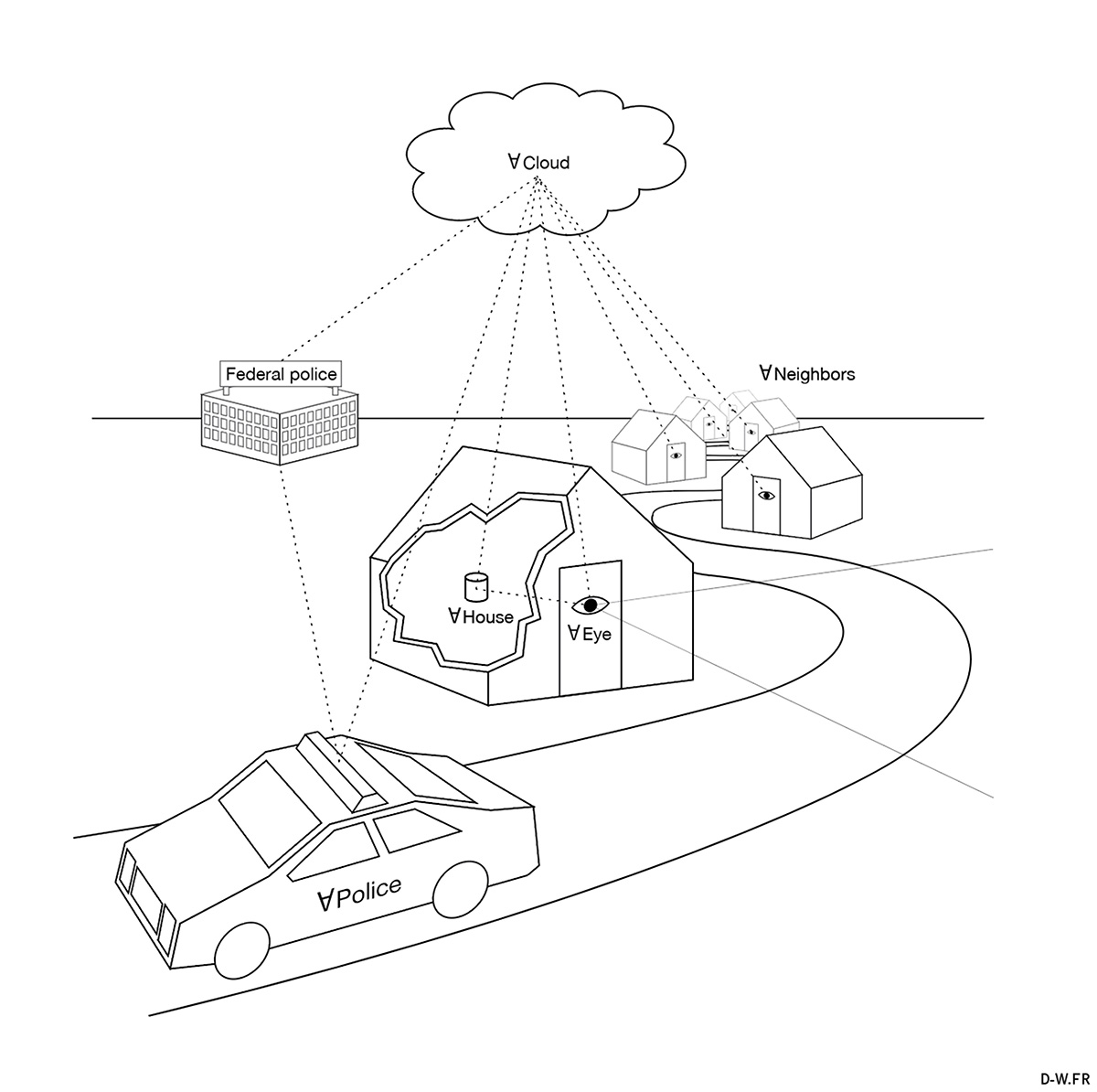
Stéphane Degoutin, Gwenola Wagon
La maison qui vous veut du bien
Experimental doc. | mov | color | 20:4 | France | 2022
La maison qui vous veut du bien La maison qui vous veut du bien est un film-essai sur l'histoire de la sonnette caméra de la société Ring rachetée par Amazon devenant en quelques années l'épicentre des objets connectées dits smart. Elle se voit envahie d'innombrables produits, éclairages, capteurs, caméras, aspirateurs, ours en peluche « intelligents » qui deviennent autant de témoins aux points de vue improbables. Des logiciels associés au réseau de surveillance des quartiers sont programmés pour analyser des comportements, ou encore des réseaux de neurones sont entraînés à reconnaître des visages captent, annotent, data minent, transforment la masse de données, filtrent par la détection biométrique assistée par du deep learning, en fonction de listes de gestes suspects, balancent leurs résultats aux officiers des polices publiques ou autres agences de sécurité... La capture sans autorisation du voisinage, l'espionnage organisé entre voisins et la disponibilité des vidéos privées pour les polices municipales font basculer le grand rêve de la maison automatisée en un cauchemar paranoïaque. Le moindre signe capté – vol d'un papillon, chien perdu, ombre d'un promeneur... – devient suspect, vient hanter les occupants de la petite maison blanche. Il se constitue progressivement un réseau d'espionnage privé en peer to peer. La bunkerisation des maisons entre dans sa phase «deep».
Stéphane Degoutin est artiste et chercheur. Ses thèmes de recherche portent sur l'humanité après l'homme, la ville après l'espace public, l'architecture après le plaisir. Ses projets enquêtent sur des situations d'ambivalence, entre la guerre et la danse, entre le plaisir sexuel et le non-lieu, entre la ville et son potentiel, entre le posthumain et l'obsolescence de l'homme. Il enseigne à l'École des Arts Décoratifs à Paris. Site internet : https://d-w.fr/ Gwenola Wagon est artiste et enseigne à l'université Paris 8 à Saint-Denis. Son travail imagine des alternatives et des récits paradoxaux pour déconstruire le monde numérique contemporain. Elle a réalisé des films et des installations pour des festivals et des expositions en France et à l'étranger. Elle a publié Psychanalyse de l'aéroport international avec Stéphane Degoutin, et le livre Planète B aux éditions 369. Site internet : https://d-w.fr/
Michelle Deignan
Catalogue : 2021Idiots | Animation | mov | black and white | 2:7 | Ireland, United Kingdom | 2020
Michelle Deignan
Idiots
Animation | mov | black and white | 2:7 | Ireland, United Kingdom | 2020
Idiots combines words and beats into an apoplectic symphony. It's language is raw and jagged, stuttering onto the screen into rants, shouts and screams. This film is angry on your behalf.
Michelle Deignan makes moving image, photographic and print works, for gallery exhibition, for cinema and for other screening contexts. With moving images she creates factual and fictional narratives that present alternative experiences and understandings of identity and place. These films often feature the triumphs and failures of protagonists struggling to be seen, remembered or heard as they fight for agency. Michelle's moving image work is distributed by LUX. She is one of a group of international women artists who collectively produce The Crown Letter, online participatory art project that began in April 2020.
Catalogue : 2017A Glimpse of Common Territory | Experimental fiction | hdv | color | 8:47 | Ireland, United Kingdom | 2015
Michelle Deignan
A Glimpse of Common Territory
Experimental fiction | hdv | color | 8:47 | Ireland, United Kingdom | 2015
By exploring representation of time, movement, fact and fiction, `A Glimpse of Common Territory` tells of the unsettling distance between what we see, what we assume and what we know. Two aristocratic characters from an 1827 sci-fi novel, "The Mummy: a Tale of the Twenty Second Century", are invoked through the words of their author. We see them overlooking the landscape from an open platform within an uncanny architectural anomaly, a 127 metre cast concrete building in the centre of a housing estate. Together they confront a crisis, their new found awareness that what they perceive, see and control are completely fictitious. Though their negotiations are precarious they reach an understanding about how they can retain a semblance of control.
Deignan has exhibited her work in over 100 exhibitions, screenings and film festivals including: ‘New Work UK - Trust Yourself’, Whitechapel Gallery, London; ‘Europart - New Contemporary Art from Europe’, Vienna; ‘Terror and the Sublime: Art and Politics in an Age of Anxiety’, Crawford Art Gallery, Cork; ‘transmediale.08’, House of Cultures, Berlin; ‘Les Rencontres Internationale’, Gaîté Lyrique, Paris; Cork International Film Festival; ‘This Fanciful Digression’, CAN, Neuchatel, Switzerland; ‘Black Box Programme’ at the Edinburgh Film Festival. Michelle Deignan’s moving image work is distributed by LUX.
Catalogue : 2016Ways to Speculate | Video | hdv | color | 3:44 | Ireland, United Kingdom | 2014
Michelle Deignan
Ways to Speculate
Video | hdv | color | 3:44 | Ireland, United Kingdom | 2014
Actual and virtual simulacra of historical European buildings, monuments and recreational spaces are presented in a tumultuous and fluctuating sonic landscape. This uncanny vision of past and present, depicting the instrumentalisation of places, is framed by two distinct voices. One languidly quotes lyrics from Kraftwerk’s Europe Endless (1977) the other earnestly performs excerpts from the introduction to the sci-fi novel, “The Mummy: A Tale of the Twenty Second Century” by Jane Webb Loudon (1827). Between them they proposes a progressive but unstable future where past dramas can easily be re-enacted.
Michelle Deignan (b. Dublin 1970) is an artist and filmmaker based in London. She has exhibited her work in over 60 national and international exhibitions, screenings and festivals including: `Public Space Ltd.`, Athens Media Art Festival;`transmediale`, House of Cultures, Berlin; `India Art Summit`, Delhi; The LUX and Cranford Collection Present: The World Turned Upside Down, Camden Arts Centre, London; `Terror and the Sublime: Art and Politics in an Age of Anxiety`, Crawford Art Gallery, Cork; `This Fanciful Digression`, CAN, Neuchatel, Switzerland. Michelle Deignan`s moving image work is distributed by LUX.
Catalogue : 2014Her Fanciful Digression | Experimental fiction | hdcam | color | 10:54 | Ireland, United Kingdom | 2012
Michelle Deignan
Her Fanciful Digression
Experimental fiction | hdcam | color | 10:54 | Ireland, United Kingdom | 2012
`Her Fanciful Digression` imagines a meeting between 19th Century Irish feminist Anna Doyle Wheeler and English landscape painter John Constable. It is set in Hatfield Forest, formerly The Houblon Estate, in South East England. Two apprentice romantics dressed in period costume repeatedly walk through the vistas of the landscape as the film`s voice over talks about the events that contribute to Constable and Wheeler`s meeting. The film considers the aesthetics of romanticism within the context of cultural, political and economic changes of the time and the application of those aesthetics in film now.
Michelle Deignan`s is an artist and filmmaker. Her work is represented by Maria Stenfors, London. She has exhibited in over 50 national and international exhibitions and festivals including: `New Work UK - Trust Yourself`, Whitechapel Gallery, London; `Europart - New Contemporary Art from Europe`, Vienna; `transmediale.08`, House of Cultures, Berlin; `Her Fanciful Digression`, Crawford Art Gallery, Cork; `Film Programme 1`, Badischer Kunstverein, Karlsruhe; `Black Box Programme` at the Edinburgh Film Festival.
Fernando Del Cubo
Catalogue : 2010Madera 22 | Experimental doc. | dv | color | 3:8 | Spain | 2009
Fernando Del Cubo
Madera 22
Experimental doc. | dv | color | 3:8 | Spain | 2009
My experience as a DJ in the eighties has provided me whith first-hand material to be abe to ofer an alternative version of the "Movida Madrileña" through events that were the general trend of group bahavoir. Violence and Drugs are one of the aspects concealed in the official history,Which insists on remembering the most playful and banal aspects. Employing a process of re-writing musical films and the appropiation of soundtracks,the video plays with the reconstruction of memory,showing up the present-day manipulation of the "nostalgia for the not experienced". Assembling real and fictitious images,Madera 22 recreates teh presentations of the first record of a "cult band ",during which the public took an LSD cocktail without teir knowledge,whith the resulting general high.
2009:Para/site-Hong Kong "Misery flae market" 2009:?Chupa-Chapa? BELLAMATIC :RIGA (Lituania)2009:?Feria? película 3m (Video ) 2009 :?Te calientan la cabeza ?? esculpture 2009: ?Trilogía de los tres minutos? 2008:?EL MOTIN DEL MOSCA? centre du art POMPIDÚ (PARIS) Rencontres internacionales Paris/Berlin/Madrid/ 2008: EL MOTÏN DEL MOSCA dentro de LHFA (Explorando Usera) MADRID ABIERTO 2007: Instalatión : MADRID HA-BIERTO 2007:?AMOR DE MOTERO?Proyect art. 2007:?MOLLERUSSA art fair ?MERCADILLO DE LA MISERIA 2007:sound sculpture?NO TE METAS DONDE NO TE LLAMAN? Proyect-film 2007: Instalatión video esculpture :MERCADILLO DE LA MISERIA (working process ) 2007:LAMASBELLA ARCO07 2006: Instalation for Art Palace 2006:PROHIBICION:Street art 2006:Aparca-coches:Sculpture street art 2005:Ape-DREAM-e: ARCO 05 2005: Performance "SUJETO VIOLENTADO" 2005:PerformanceHOAX:Video-performance 2004:?La mujer inventada? esculturas relacionadas 2004:? MeCaGo`NL amorrr? Sculpture.
Catalogue : 2009EL MOTIN DEL MOSCA | Experimental doc. | dv | color | 3:42 | Spain | 2008

Fernando Del Cubo
EL MOTIN DEL MOSCA
Experimental doc. | dv | color | 3:42 | Spain | 2008
1980 Madrid,Lou Reed makes a concert in "usera" neighborhood. Too much yonkees,too much violence !!!
Cubo 1967 video-performance video art Sculpture http://es.geocities.com/cuboart/index.htm
Diego Del Pozo Barriuso
Catalogue : 2013APRENDER FÍSICA | Video | hdv | color | 13:23 | Spain | 2012
Diego Del Pozo Barriuso
APRENDER FÍSICA
Video | hdv | color | 13:23 | Spain | 2012
Learning Physics Video HD. 13´ 23´´ Single Channel Color, Stereo 2012 Learning Physics raises the importance of reinterpreting history, and to read in the present its possible transformations as an exercise of questioning what is experienced, and of the vision and of how we see? What do we see? Who has the privilege of handling various points of view and why? Why some people blind others or why some people deliberately covers their eyes? It addresses the problem of vision when agreeing the boundaries of the territories and their organization, the boundaries between variable and invariable in the imagination and construction of futures. In the video essay there is a connection between the current financial crisis, the contemporary scientific revolutions and experiences of Huesca and Jaen collectivists at the time of the Spanish Civil War.
Lives and works in Madrid. Artist and cultural producer, member of the collective CASITA and professor at the Faculty of Fine Arts at the University of Salamanca. Among of his solo exhibitions include those in the CAB of Burgos in 2011, ECAT in Toledo in 2009, at the Cultural Center Montehermoso of Vitoria in 2007 and at the Contemporary Art Center of Salamanca, DA2 in 2006. He has participated in group exhibitions including: Educating Knowledge, MUSAC, Leon (2010); Apres la fin / valeur travail, Haus der Culturen der Welt, Berlin, Germany (2009); Heterotopías, Oktogon HFBK, Dresden, Germany (2007 ) Destination future, Royal Botanic Gardens, Madrid (2007), Terraplane blues, The Burning House, Madrid (2006); Radicáis free, Auditorio de Galicia in Santiago (2005). His videos have been programmed into the International Video Rencontres Paris / Madrid / Berlin, Theatre du Chatelet, Paris, MNCA Reina Sofia, Madrid and Jeu de Paume, Paris in 2008 and 2011. His work is also in collections such as the Leon MUSAC or Domus Artium 2002 Salamanca (DA2). Villaplana.!
Catalogue : 2011ACCIONES SINUOSAS | Art vidéo | dv | black and white | 5:6 | Spain | 2010
Diego Del Pozo Barriuso
ACCIONES SINUOSAS
Art vidéo | dv | black and white | 5:6 | Spain | 2010
Sinuous actions reflects a memory of the most important disagreements that have been pronounced by various social and political movements in different contexts. It shows different strategies of these movements using disguises and changes of indentity in order to get their goals or to put in evidence the contraditions of the system. Sinuous actions proposes a set of multiple clashes. Not only for the use of two screens but for showing different types of masks which operate on different levels of power (patriarchal heteronormativity, globalization, intolerance for ideas policies,...). At the same time this work visualizes unconscious gestures of any person which present different ways of hiding. We can hide ourself, by imposed cause or by incidental situation. These gestures could suggest different ways of understanding and changing subjectivities from individual position to collectives positions.
Diego del Pozo Barriuso lives and works in Madrid. He studied at the Faculty of Fine Art in Salamanca and Madrid, and at the Gerrit Rietveld Academie in Amsterdam. Artist and cultural producer, he develops projects about the social production of the body and identity. His work is based on his concern about affection and desire and the way in which these emotions, associated with subjective, private experience are conditioned by our social environment, by power and by production methods. His work is based on the idea that social control mechanisms are interiorised by individuals, and he shows how the cracks in these tools of power come into conflict and create contradictions within us. He also works with the group C.A.S.I.T.A. (www.ganarselavida.net) His work forms part, among other collections, of the collection of the MUSAC of León, Spain, and of the collection of DA2, the Centre of Contemporary Art of Salamanca, Spain.
Catalogue : 2010PIEZA PARA ORGÍA Y FÁBRICA | Animation | dv | black and white | 6:42 | Spain | 2006
Diego Del Pozo Barriuso
PIEZA PARA ORGÍA Y FÁBRICA
Animation | dv | black and white | 6:42 | Spain | 2006
This is a piece about loneliness, about the need for affection and about how the contemporary subject is submerged in the strive for a resolution of these lacks in the context of the work and production system. The images represent a number of different individuals in two completely different situations, and some of them participate in both: some people have just taken part in an orgy, while others are at work, in different working environments (an office, a production line, a workshop, a school, a hospital). We witness the interior monologues of all these people. They are never alone in these situations, but they feel lonely. Their intimate thoughts come in succession, never simultaneously.
Diego del Pozo Barriuso lives and works in Madrid. He studied at the Faculty of Fine Art in Salamanca and Madrid, and at the Gerrit Rietveld Academie in Amsterdam. Artist and cultural producer, he develops projects about the social production of the body and identity. His work is based on his concern about affection and desire and the way in which these emotions, associated with subjective, private experience are conditioned by our social environment, by power and by production methods. His work is based on the idea that social control mechanisms are interiorised by individuals, and he shows how the cracks in these tools of power come into conflict and create contradictions within us. He also works with the group C.A.S.I.T.A. (www.ganarselavida.net) His work forms part, among other collections, of the collection of the MUSAC of León, Spain, and of the collection of DA2, the Centre of Contemporary Art of Salamanca, Spain.
Catalogue : 2009EL TOPO Y LA ANGUILA | Art vidéo | dv | color | 5:2 | Spain | 2007

Diego Del Pozo Barriuso
EL TOPO Y LA ANGUILA
Art vidéo | dv | color | 5:2 | Spain | 2007
THE MOLE AND THE EEL This is a piece about Exchange, affective work and the relationship between Economy and Affection. It is the story of two clandestine groups that have invented another economy in a period of war. The individuals who belong to these two groups choose a somewhat precarious existence within an economy of supposed abundance. It is the story of two groups of anonymous people who belong to different levels of production and class. They look for subjective action through emancipation in the chain of exchange of affections. The city, the river, the island and the people?s networks work symbolically in the movie and force one to think about contemporary contradictions and problems. For the ?Rencontres Internationales festival? The Mole and the Eel is in an only monocanal version, but it also works on video ? installation format, together with another video and several series of drawings.
DIEGO DEL POZO BARRIUSO Valladolid (Spain), 1974. He lives and works in Madrid, Spain. He studied at the Faculty of Fine Art in Salamanca and Madrid, and at the Gerrit Rietveld Academie in Amsterdam. Artist and cultural producer, he develops projects about the social production of the body and identity. His work is based on his concern about affection, love and desire and the way in which these emotions, associated with subjective, private experience are conditioned by our social environment, by power and by production methods. His work is based on the idea that social control mechanisms are interiorised by individuals, and he shows how the cracks in these tools of power come into conflict and create contradictions within us. Using different techniques and media- drawing, installations, video?- he brings us face to face with a reality in which our desires, which we assume to be our own and private, are exposed as constructions that prompt consumption or social control. He also works with the group C.A.S.I.T.A. His work forms part, among other collections, of the collection of the MUSAC of León, Spain, and of the collection of DA2, the Centre of Contemporary Art of Salamanca, Spain.
Liryc Dela Cruz
Catalogue : 2022Santelmo | Experimental fiction | hdcam | black and white | 52:28 | Philippines | 2021
Liryc Dela Cruz
Santelmo
Experimental fiction | hdcam | black and white | 52:28 | Philippines | 2021
Encyclopaedias describe St. Elmo's fire as a harmless meteorological phenomenon caused by a strong static discharge. In Philippine mythology, a "santelmo" is a wandering soul of a deceased person who has not found peace yet. Three young men wandering through countryside seeking in vain reconciliation with the world. Their aimless journey is accompanied by rustling of leaves and grass, chirping of insects, and singing of birds, conversations about people for whom they have suffered and whom they plan to take revenge on. Yet, they are prevented from freeing themselves by memories that cannot be killed.
Liryc Dela Cruz (1992) is an artist and filmmaker from Tupi, South Cotabato in Mindanao, Philippines and now based in Rome, Italy. His works were selected and screened in different international film festivals and art events. His debut short film “The Ebb of Forgetting” premiered at the prestigious 68th Locarno Film Festival. His films are thematically related to his origins, history, and personal psychology. His works outside cinema focuses on care, indegenous practices, decolonial practices, post-colonial Philippines, transpacific slave trade, hospitality and reconnecting the colonized and slave body to the soil. Dela Cruz was one of the key collaborators of Philippine independent master filmmaker Lav Diaz. He is also considered as one of the representatives of the slow cinema movement (Ji.hlava IDFF ‘18). In 2019, he represented Italy at the UK Young Artist in Nottingham, he was selected as one of the artists of AtWork Venice mentored by Simon Njami and was the Editor in Chief of the Where is South exhibition at the Palazzo Querini, Fondazione Ugo e Olga Levi as part of the “Rothko in Lampedusa'' initiative during the 58th Venice Biennale. In 2020, he was selected as one of the young emerging filmmakers to represent Italy in Berlinale Talents during the 70th Berlin International Film Festival. Dela Cruz was also mentored by French Political Scientist and Activist, Françoise Vergès during the Mediterranean Ecofeminist Decolonial Union for Self-Education in Lecce, Italy. Recently, he debuted a performance in Teatro di Roma - Teatro Nazionale in Rome as part of his ongoing research project “Il Mio Filippino/a,” a project about “gestures of care and cleaning methods” of Filipino cleaning workers. The same project was also a recipient of Artissima - Torino Social Impact Art Award for the year 2020 and has been selected by Cité internationale des arts Paris for their residency program in 2022 and by Mattatoio di Roma for its Prender-si Cura residency programme. Currently, Dela Cruz is developing “Ocean as a Space of Perpetual Care '' a project based on indigenous care and hospitality of pre-colonial Filipinos and from the diary of Antonio Pigafetta.
Marion Delaballe
Catalogue : 2007Tour(s) | Video installation | dv | color | 10:0 | France | 2005
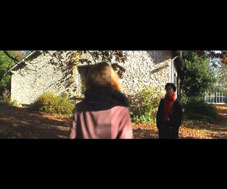
Marion Delaballe
Tour(s)
Video installation | dv | color | 10:0 | France | 2005
A scenery - an attempt promontory for his stabiles. A 360° of two camera that take a relay of images from one to the other, forming a 16/9 centring. Capturing the spectator's attention in an initial vision of a smooth and attractive image. Then, this image dilates in its centre : a junction of pixels. Shocks are created, disturbing the harmony of the plan-sequence. The bodies divide in two or disappear, tallying the faults of a apparatus that has established itself on a screen form, shot, a circumference of images: the trompe l'oeil of a decor in a film pre-narration.
At 26 years old, Marion Delabelle lives and works in Paris, where she was born. She studied at the Beaux Arts in Valence and received a D.N.S.E.P. Art diploma in June 2005. She is specialized in videographic installations which are based on specific film processes (morphing, double camera, chrono-photography,...).
Mathias Delfau
Catalogue : 20118 | Animation | | color | 17:13 | France | 2010
Mathias Delfau
8
Animation | | color | 17:13 | France | 2010
8 Un film d?animation de Mathias Delfau (2010 ? 17mn) Après avoir travaillé avec Noëlle Renaude à la mise en page d?Une belle journée et de Topographie, où la recherche portait sur une mise en espace du déroulement du texte sur la page, j?ai cherché à mettre en scène une partie de sa pièce 8 dans l?espace 3D et le temps d?un film d?animation. Ce travail est la rencontre entre une recherche picturale abstraite et une situation incarnée par les 5 personnages de la pièce. 8 est avant tout un procédé, celui de ne pas donner à voir, ni à entendre la pièce telle qu?elle pourrait être jouée sur scène, mais à montrer les traces qu?elle pourrait produire. Ne pas chercher le sens mais le laisser apparaître dans les traces laissées par ces phrases qui sont dites sans trop réfléchir à leurs portées, au gré de l?action, mais qui restent et influent sur le déroulement, dans les méandres des traces laissées par les déplacements de ces cinq personnages qui s?attirent et se repoussent au sein de ce qu?on pourrait appeler un groupe. Juste garder la subjectivité de l?axe de la caméra, comme celle des didascalies dans la pièce, le mouvement de la caméra crée un second plan détaché de l?action. 8 est une sorte d?observatoire où l?action se déroule en même temps qu?elle est observée, dans ce qu?elle est et dans ce qu?elle produit.
Je travaille avec des créateurs dans des domaines différents et c`est de ce va-et-vient entre l`art plastique, l`art numérique, le spectacle vivant et la littérature, qu`est né le film 8.
Catalogue : 2008MUR | Animation | 0 | color | 6:26 | France | 2006
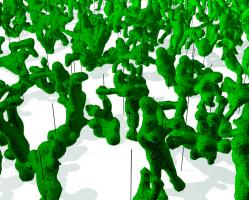
Mathias Delfau
MUR
Animation | 0 | color | 6:26 | France | 2006
Mur, c?est la rencontre violente de deux points de vue. De l?extérieur, c?est un motif, sorte de treille végétale plus ou moins régulière. Dans la violence des percussions, la caméra semble hésiter face au mur, puis elle est projetée contre le motif. De l?intérieur, silence, le motif se découvre en volume, construit à partir de formes anthropomorphes, postures figées et épinglées de façon régulière sur le tracé du motif. La caméra découvre la particularité de chacun de ces corps, le motif est oublié, il est vu dans l?accumulation d?individualité dont il est formé. C?est de la répétition de ce passage entre le bruit et le silence, la forme et son sens que va naître MUR.
Mathias Delfau (1968) : je travaille comme designer graphique, plasticien et artiste numérique. Mon travail sur l?image s?est développé au moyen de différents médias. D?abord la peinture (1988/1999). Puis avec la scénographie et le spectacle, l?image est pensée dans l?espace (de 1995 à 1999 j?ai monté trois spectacles confrontant l?acteur à l?image). Enfin la vidéo en 1997 avec l?arrivée du numérique, parce qu?elle est le support parfait pour une recherche sur le montage, sur le passage progressif d?une image fixe à 25 images seconde. Pendant 7 ans, j?ai travaillé la vidéo sur ordinateur comme la peinture, couche après couche par superposition. Au service de la composition plus que de l?histoire. J?ai mâché cette matière numérique en produisant beaucoup de petites choses qui n?avaient d?autres buts que le temps passé à les faire. Depuis 2000, je travaille aussi avec le groupe d?artiste Accès local dont le but est de replacer la recherche artistique dans un contexte social et professionnel. Aujourd?hui, je n?utilise plus la vidéo mais l?animation 3D qui me permet de continuer ma recherche sur le dessin dans l?espace.
Catalogue : 2007HA | Animation | 0 | color | 5:0 | France | 2006
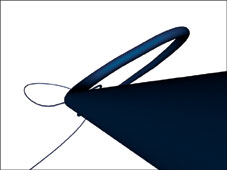
Mathias Delfau
HA
Animation | 0 | color | 5:0 | France | 2006
The animation "HA" seems to be an outcome of the films produced since 1991. Video images meet their digital manipulation, a game of hidden/shown, that led to the disappearance and the recovery of extra-work by the 3-D image ("C'est Clair", 2003), only the drawing and the line remained. "HA" is also the balancing point between narration and pattern; as animation does not really have a beginning and an end, it can be glanced at or watched throughout its duration. It is also meant to have the viewer, thanks to a fun activity (following the line like Russian mountains), spend some time before this line that is being drawn according to the look that we give it, continuously changing from a physical impression of space to the drawing that comes to life on the screen.
Mathias Delfau, born 1968. He works as a graphist, plastician, and video artist. 1985-1994 Through painting he sees that the image as a finite surface can embody the most infinite of spaces. The image as vocabulary for a non-demonstrative speech. 1987-1992 He pursues plastician studies in the field of architectural environment at the Applied Arts School of Paris (BTS), and painting at the Fine Arts School of Paris, to think about the paradoxical notion of applied art. 1992-1995 Works part-time as exhibition assistant at the Galerie Nationale du Jeu de Paume, Paris. 1993-1994 Conception and production of exhibitions for the French film library. 1992-1995 Directs three shows involving manipulation of images. 1994-2006 Pursues painting through digital video and produces several animation films. 1997-2003 Works part-time as a creator in a graphist agency specialized in cultural communication. 2000-2006 Collaborates and exhibits with the artists' group "Accès Local", the goal of which is to put artistic research back into a social context. 2003-2006 Works independently with print works (posters, tablets, editing, artwork), animated works (internet sites, casing, videos), and directing (signage, seat of reception, factual). 2003-2006 Fixed images using large colour prints, and apparently simple sculptural forms reconstructed from hundreds of macro-photographs. 2004-2005 With the installation "Madame T", video is placed into space and at the heart of another identical installation confronts different medias, each one taking charge of one facet of history. 2006 Foundation of the OA association, a legal structure giving artists complementary know-how by working together to conceive, produce, and distribute original communication forms that are light and mobile and that can be easily integrated into varying public spaces.
Catalogue : 2006Blahblah | Experimental video | dv | black and white | 4:16 | France | 2005
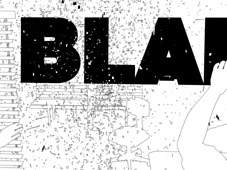
Mathias Delfau
Blahblah
Experimental video | dv | black and white | 4:16 | France | 2005
Blah Blah is a film behind closed doors where each protagonist is reduced to one action. This is also a redundant merry go a round of Muppet that go up and down. As jack in the box, but there is no sound in Blah blah. The only thing that unfolds et that is told are words, not in their meaning but in the shifting. Blah Blah is a society parody where life is born from interaction, a word flipper which flood as more importance than sound.
Mathias Delfau is born in 1968. He is working as a graphic artist, a plastic artist and video artist in the same time. From 87 to 92, he studied plastic of environment of architecture at the Arts Appliqués of Paris and paintings at the Beaux-Arts of Paris. Then, for two years, he staged three shows of images manipulation. Unitl 2005, he continued his work of painter through digital video and makes numerous films of animation. From 97 to 03, he kept also a part time job in a graphic agency. Starting 2000 for five years, the artist decided to collaborate with a group, Accès Local, which goal was to switch the artistic research into a social context. He also worked for three years (2000-2003) independently for printed works (posters, booklets, editing, illustration), animated movies (websites, clothing, video) and spacing (signs, welcome sites, events). This last year, he took part into Madame T installation which space faces installation, still image and motion image in the same place.
Daniela Delgado Viteri
Catalogue : 2014Monstruo | Experimental film | 16mm | black and white | 15:6 | Ecuador, Argentina | 2013
Daniela Delgado Viteri
Monstruo
Experimental film | 16mm | black and white | 15:6 | Ecuador, Argentina | 2013
There are mass suicides and there are mass naps. They seem pretty close but they actually have different ontological dimensions. This film is about a mass nap and some mysterious acts of violence that are not taken very seriously. There is not much more to say. However, I would like to add the fact that I believe this film is very serious due to the fact that doesn?t take itself seriously.
Daniela Delgado was born in Ecuador in 1987. She studied film at Universidad del Cine in Buenos Aires. She wrote and directed short films screened at Rotterdam Film Festival, Split Film Festival, Bienal of Moving Image in Buenos Aires, Museum of Modern Art in Buenos Aires and Semana del Cine Experimental in Madrid. She participated at the Berlinale Talent Campus #10 (2012). She is currently a scholarhip holder at the Centre of Investigation of the Arts in Buenos Aires.
Alix Delmas
Catalogue : 2011commencement | Art vidéo | dv | color | 7:0 | France | 2010
Alix Delmas
commencement
Art vidéo | dv | color | 7:0 | France | 2010
Dans cette vidéo inspirée du cinéma muet, dans une forêt, des ouvriers aidés de leurs machines creusent un trou en pleine forêt. Pour déplanter un arbre? Le trou s`allonge. Mais que creusent-ils ? Une tombe, une fosse septique, les fondations d?une maison ?
Vit et travaille à Paris. Diplômée de l?Ecole supérieure des Beaux-Arts en 1987, sa pratique artistique réunit le dessin, la photgraphie, la vidéo, l'installation in situ. Son travail a été exposé notamment au FRAC Auvergne, au Musée d?Art Moderne de la Ville de Paris, à la Biennale d?Art Contemporain du Littoral à Anglet, au Salon du dessin contemporain de Paris, à la Galerie Yvon Lambert à Paris. Son travail fait partie de collections notamment du FNAC Fonds National d?Art Contemporain, du FRAC Auvergne, du Landes Museum de Linz en Autriche, du Albertina Museum à Vienne en Autriche, de la Collection Weil, Gotshal and Manges à New York.
Catalogue : 2010SALSAS EN LAS BARDENAS REALES | Experimental fiction | | color | 13:50 | France, Spain | 2007
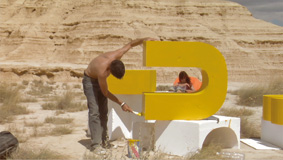
Alix Delmas
SALSAS EN LAS BARDENAS REALES
Experimental fiction | | color | 13:50 | France, Spain | 2007
Synopsis It is very early in the morning. Four people are driving through the desert. Three men embark on an expedition to unload a set. They form, paint and put up polystyrene shapes in a location worthy of the classic Westerns. And all the time, a strawberry blonde is lounging around doing her crosswords. At the centre of the three handsome young workers, she rotates her deckchair like the hands of a watch linked to the path of the sun, until dusk, when the installation is unveiled.
Alexandra Dementieva
Catalogue : 2007Mad Professor | Experimental fiction | dv | color | 4:42 | Belgium | 2005
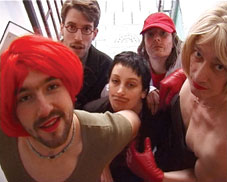
Alexandra Dementieva
Mad Professor
Experimental fiction | dv | color | 4:42 | Belgium | 2005
"Mad Professor" was made during a one week residence at Netwerk Art Center in Aalst, Belgium. It is a part of a Paul Deschanel Movement Research Group project. The theme was 'Humour & Gender'. The film can be viewed as a collaboration of all the participants. Tinkering with the borders between art and life, between an institutionalised art world and pop culture, between high and low, performance invokes strategies of humour and plays with gender issues. Humour serves as the jester?s vehicle to puncture decorum and create idiosyncratic forms and hierarchies. Gender pervades our taste and manners as well, often unnoticed or unspoken, as a persistent cultural residue that haunts the so-called formal aspects of life. Can humour and gender reinforce one another on this point, as a critical artistic strategy? Or do they have different interests? Since it concerns ourselves, whether we like it or not, doesn?t gender prompt us beyond irony? Humour on the other hand might be a comfortable practice of distancing, but isn?t it also an essential exercise in lightness?
Alexandra Dementieva studied journalism and fine arts. Her main interests are focused on social psychology and perception and their application in multimedia interactive installations. Her video work integrates different elements including behavioural psychology, developing narrative through the point of view of a subjective camera. Her video and multimedia works have been exhibited internationally. Paul Deschanel Movement Research Group The Paul Deschanel Movement Research Group tinkers with a process-oriented approach of movement research, claiming fundamental research as a prerequisite for artistic sustainability. Particular attention is devoted to collaboration and exchange, environmental awareness and a consciousness of physical and cultural borders.
Catalogue : 2006Do you remember | Experimental film | dv | black and white | 6:6 | Belgium | 2005

Alexandra Dementieva
Do you remember
Experimental film | dv | black and white | 6:6 | Belgium | 2005
Stories and legends about numbers are very popular in human history. What does mean following the numbers and what kind of associations could be spelled by some of them? Personage of subjective camera is chasing magic combination becoming the part of strange and fragile world of dreams and loosing the control over the reality.
Alexandra Dementieva?s main interest is application of social psychology and perception in multimedia interactive installations. Her video work integrates different elements, including behavioral psychology and developing narrative through a point of view of subjective camera. Her interactive installation projects attempt to widen mind`s perception possibilities by different production means: computers, video projections, use of sound bands, slides, photography, etc. By making certain historical, cultural and political allusions her exhibition sites create the frame within which the idea develops. The projects explore spectator?s depths of perceptional experience and interaction of an individual spectator with the exhibition proper, as well as with other visitors. The object on an installation or its production means become less important to her than the mind of a user. Thus the latter becomes the center of the project or the main actor of the performance. Her installations resemble questionnairs that may or may not be answered only with spectator?s participation.
Stijn Demeulenaere, Jan Locus
Catalogue : 2020Murmur | Experimental doc. | 4k | black and white | 10:21 | Belgium | 2019
Stijn Demeulenaere, Jan Locus
Murmur
Experimental doc. | 4k | black and white | 10:21 | Belgium | 2019
Brussels was built on a swamp. Today, only one tiny part of Brussels is still officially a swamp. Although continually threatened by development the area stayed intact, largely due to being ensnared between two railroad tracks. Further enclosed by high-rise social housing and industrial areas just behind these railroads, the swamp is a mix of damp prairies and patches of bushes and trees. It’s home to a lot of small wildlife such as birds, rodents, bats, amphibians and even ringed snakes. A small green oasis, in the middle of a concrete landscape. Murmur is a collaboration between film maker Jan Locus and sound artist Stijn Demeulenaere. Just before first light, Jan and Stijn recorded the dawn chorus at the swamp. The city drone permeates the sound of the swamp, and a strange mix enfolds between the sound of an awakening nature and a human presence. Urban drone and bird song merge into an (un)familiar murmur presence in the twilight hour of the morning.
JAN LOCUS The long-term projects of photographer and filmmaker Jan Locus study the complexity of worldwide, socio-political issues. He had exhibitions at FOMU Antwerp, Noorderlicht Photo Festival Groningen, Iklectik Art Lab London, De Brakke Grond Amsterdam, and Les Rencontres d’Arles. His photography books include “Mongolia”, “De Bewegende Stad”, and “Devoted.” Jans films have been shown at film festivals including IFFR Rotterdam, DokFest Kassel and International Short Film Festival Oberhausen. He lives and works in Brussels. STIJN DEMEULENAERE Stijn Demeulenaere is sound artist and field recordist. He creates installations, soundscapes, performances, and does sound design for dance and theatre. Stijn researches the relationship between identity, sound and listening. His work was shown at, among others, Concertgebouw Bruges, NIMk (NL), Den Frie (DK), STUK (BE), Kaaitheater (BE), New adventures in Sound Art (CA), and IFFR Rotterdam. His work was nominated for the LOOP Discovery Award, the European Sound Art Award, and it won prizes at the Engine Room International Sound Art Award and the Musica Soundscape Award. He lives and works in Brussels.
Stefan Demming
Catalogue : 2006Conzerrrt in streifen | Art vidéo | dv | color | 3:23 | Germany, Mexico | 2005
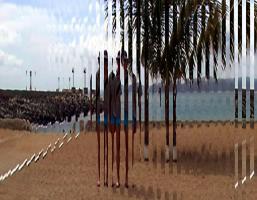
Stefan Demming
Conzerrrt in streifen
Art vidéo | dv | color | 3:23 | Germany, Mexico | 2005
Conzerrrt in Streifen 3`23``, DVD, stereo, couleur, 2005 Musique: Brigitta Muntendorf Vidéo: Stefan Demming Un touriste prend la pose dans une station thermale, jusqu'à ce qu'il se passe une chose dans laquelle sont impliqués une noyée et un sauveur masqué - jusqu'à une douteuse happy end. L'image est continuellement découpée en de nouvelles bandes et combinée avec elle-même.
Stefan Demming (* 1973) Licence d'art et d'histoire (1999), travail sur des bandes vidéo et des installations à l'Atelier für Zeitmedien à Brême (A;1999 -2005), chez V2_Organisation, Rotterdam (PB: 2002/3), séjour d'études à Marseille (F: 2005) http://stemming.free.fr
- Democracia
Catalogue : 2010Ne vous laissez pas consoler | Art vidéo | 16mm | color | 17:4 | Spain | 2009

- Democracia
Ne vous laissez pas consoler
Art vidéo | 16mm | color | 17:4 | Spain | 2009
In Ne vous laissez pas consoler Democracia collaborates with the Ultramarines, hooligans of the football team Girondins from Bourdeaux, intervening with the introduction of political sentences (via banners and merchandising paraphernalia) into a completely unusual context: a football stadium in full activity, questioning the logical structure of the spectacle. The protagonist of the film are the spectators, from entering the stadium until they leave, the game is never filmed.
After having founded the group El Perro (1989-2006), Pablo España and Iván López (1970, Madrid, Spain) formed Democracia (2006), a name synonymous with an artistic approach committed to exchanging ideas and practices along strong ethical and social lines. Their projects bear witness to an interest in scenes from social and everyday life, marked by the growing importance of images and the notion of â??simulacraâ?�, from the political, technological and cultural perspectives. Democracia had been participated at Evento 2009, Burdeos, France; X Bienal de la Habana (2009), Cuba; Taipei Biennial 2008, Taiwan; 10 Estambul Biennial, Turkey; 3rd Goteborg Biennial, Sweden . The Democracia collective is also the brains behind the magazine Nolens Volens and is the organizing body for numerous curatorial projects (Madrid Abierto 2008, No Futuro, ONG, Caracas, 2007).
Martine Dempsey
Catalogue : 2006Showertime | Art vidéo | dv | color | 2:25 | United Kingdom | 2005
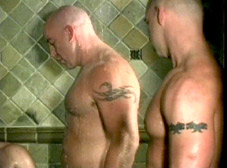
Martine Dempsey
Showertime
Art vidéo | dv | color | 2:25 | United Kingdom | 2005
In my videos I have been using appropriation as a sort of blue print or ?toolbox? from which to mine. In the same way the DJ samples and remixes music, I am interested in methods of reproducing and recontextualising images. Rather than seemly creating something from scratch, I am interested in editing and shaping what already exists in the world. Through exploring the use of found footage the role of the director is replaced with that of the editor. I actively manipulate the medium through looping, erasing and compressing moving images. I am interested in manipulating moving images in a way that `work for us` rather than passively `working on us`. I use this methodology in my video Showertime. This film explores homosexual eroticism/pornography where feelings of ecstasy extend outwards beyond the screen to the viewer. The work also hints at the notion of the sublime ? the kind of pleasure that can only be experienced indirectly, that which defies logic and rationality.
Born 1967, England Living and working in London BA (Hons) Fine Art Chelsea College of Art and Design, London
Catalogue : 2006Why Are They All Going Mad? | Art vidéo | dv | color | 2:4 | United Kingdom | 2004
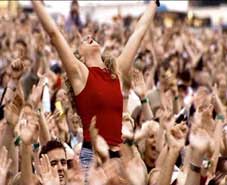
Martine Dempsey
Why Are They All Going Mad?
Art vidéo | dv | color | 2:4 | United Kingdom | 2004
In my videos I have been using appropriation as a sort of blue print or ?toolbox? from which to mine. In the same way the DJ samples and remixes music, I am interested in methods of reproducing and recontextualising images. Rather than seemly creating something from scratch, I am interested in editing and shaping what already exists in the world. Through exploring the use of found footage the role of the director is replaced with that of the editor. I actively manipulate the medium through looping, erasing and compressing moving images. I am interested in manipulating moving images in a way that `work for us` rather than passively `working on us`. I use this methodology in my video Why Are They All Going Mad? This work hints at the notion of the sublime ? the kind of pleasure that can only be experienced indirectly, that which defies logic and rationality.
Born 1967, England Living and working in London BA (Hons) Fine Art Chelsea College of Art and Design, London